An underrated but long-revered staple in Mexican cuisine might be hiding in plain sight in your supermarket produce aisle. Jicama — pronounced hic-kah-muh in English and hee-kah-muh in Spanish is the odd-looking love child of a giant water chestnut and a potato — with the crispness of an apple.
Jicama has a mild, slightly sweet, and refreshing taste. Its crisp, juicy texture pairs well with savory and sweet dishes, making it a versatile ingredient in salads, slaws, and snacks.
Though unremarkable in appearance, this vegetable offers a unique taste, a stellar nutritional profile, and several potential health benefits that make it worth trying. Although it’s still relatively new to many people outside Mexico, Latin America, and the Southwestern US, jicama has grown in popularity due to its raw or cooked culinary versatility.
So what are the health benefits of jicama? Are there any downsides to eating it? And how do you store and eat jicama?
What Is Jicama?
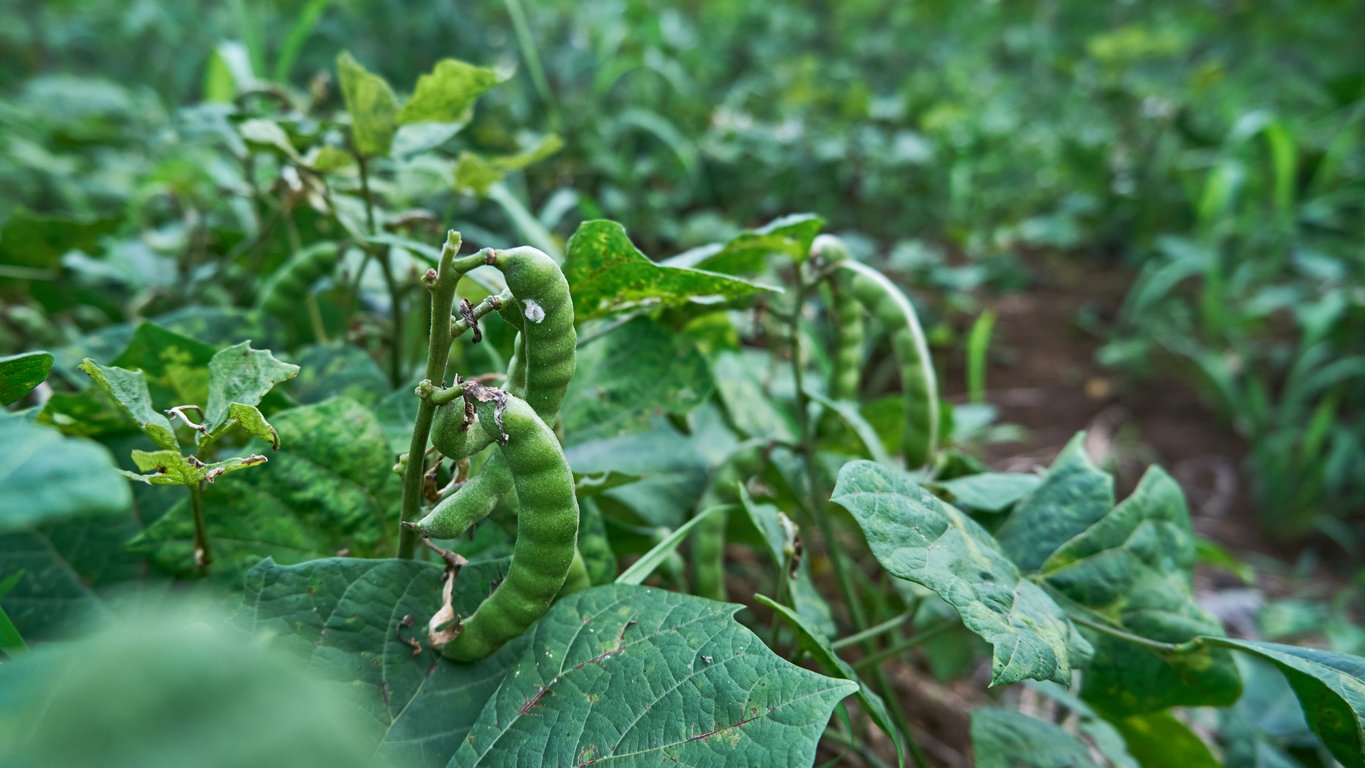
Is jicama a fruit? A vegetable? A root? Something else altogether? Although you can treat it as all of these things, jicama is technically a root vegetable (more specifically, a tuber) in the pea family. The edible taproots of the bean-producing Pachyrhizus erosus plant form underground, while the above-ground plant grows as a vine along the surface. However, the roots are the only parts of this plant you can eat.
The jicama plant’s leaves, seeds, and flowers are toxic and are not edible. Only the roots of the plant are sold in grocery stores and markets. Keep this in mind if you ever grow or harvest jicama in your garden.
If you are interested in growing jicama, it does well in USDA zones 7 through 10. Jicama thrives in hot climates and is native to Mexico, although it’s also grown abundantly in parts of Asia and the Philippines.
Jicama might not be as common as other root vegetables outside of Mexico and Central America. But if you do spot it, it might also be called Mexican potato, sweet turnip, Mexican turnip, Mexican yam bean, or Chinese potato.
Jicama Nutrition Facts
Jicama is a solid source of important macro- and micronutrients. The calories in jicama are mostly carbohydrates. But they are complex carbs, meaning they’re largely made up of fiber (in this case, both soluble and insoluble fiber). Jicama also contains the prebiotic fiber inulin, which has several proven health benefits (which I’ll discuss below).
A one-cup serving of jicama contains 46 calories along with the following notable nutrients:
- Carbohydrates: 10.6 grams
- Fiber: 5.9 grams (i.e., most of the carbohydrates)
- Protein: 0.86 grams
- Vitamin C: 27% of Recommended Daily Intake (RDI)
- Folate (B9): 4% of RDI
- Vitamin E: 4% of RDI
- Potassium: 4% of RDI
- Copper: 6% of RDI
- Iron: 4% of RDI
Jicama also contains small amounts of B vitamins and trace minerals like zinc, selenium, manganese, and phosphorus.
4 Health Benefits of Jicama
There aren’t very many studies that specifically look at jicama’s effect on various diseases and conditions. And many of the ones that do use animals instead of human subjects. Nevertheless, there’s a lot to like about jicama. Here’s what we do know about its potential health benefits.
1. Jicama and Gut Health

If you want a healthy gut, you need to consume enough dietary fiber (a feat that roughly 97% of Americans don’t accomplish). Eating enough fiber adds bulk to your stool, keeps things moving regularly through your intestines, nourishes the microorganisms in your gut, and reduces your risk of various digestive diseases and disorders.
Jicama is an all-star source of fiber, particularly a type of soluble fiber called inulin. Inulin is prebiotic, meaning it feeds your probiotics — the good bacteria in your gut — so they can do their job and keep you healthy.
In animal studies (our view on animals in medical research is here), jicama has shown potential in modifying gut microbiota by increasing beneficial strains like Lactobacillus reuteri and inhibiting pathogens like Mucispirillum sp. from taking hold. The inulin fiber in jicama also acts as an anti-inflammatory and may help prevent dysbiosis.
2. Jicama and Diabetes
Jicama also has unique properties that can help regulate blood glucose and control conditions like type 2 diabetes. A 2016 study in mice found that six weeks of jicama extract administration significantly reduced blood sugar and HbA1c levels while increasing insulin sensitivity. Similarly, a 2019 animal study also found that jicama fiber (inulin) prevented blood sugar spikes and weight gain, even while the animals were subjected to a very inhumane high-sugar diet.
Despite its pleasantly sweet taste, jicama boasts a low glycemic load. The fiber in jicama not only slows down digestion but also aids in weight loss, primarily by increasing satiety (a fancy word that means that it makes you feel full). Since obesity is a risk factor for the development of type 2 diabetes, jicama’s weight management effect is another way it contributes to fighting diabetes.
3. Jicama and Heart Benefits

By helping to lower blood sugar and improve insulin sensitivity, jicama also reduces your risk for cardiovascular disease. And jicama’s fiber isn’t the only part that’s good for your heart.
In a 2016 study, healthy adults who consumed 500 ml of jicama juice reduced their risk of developing blood clots compared to a control group who drank guava juice and water. Jicama juice produces nitric oxide in the body, an important compound that helps arteries relax, reduces blood pressure, and reduces the risk of heart attack and stroke.
4. Benefits Your Bones:
The inulin in jicama can support bone health by retaining minerals in your bones, improving calcium absorption, and reducing bone loss. That’s especially helpful since jicama contains a small amount of calcium, so the fiber helps make it more bioavailable to you.
Jicama root extract also shows potential in preventing osteoporosis in animal models due to the presence of phytoestrogens. In an older study designed to mimic the effect of jicama on postmenopausal women, bone density, length, and strength all increased with jicama extract.
Jicama Side Effects and Other Downsides
Despite its many health benefits, jicama has a few downsides. It is generally safe for the average person, but as with any food, it should be enjoyed as part of a diverse and well-balanced diet.
Jicama Allergy

Although uncommon, jicama allergies do occur in some individuals. Because the jicama plant is in the legume family, it’s possible to react if you’re allergic to other legumes like peanuts or soy.
Seasonal allergies to trees and grasses can also trigger oral allergy syndrome, in which the body confuses the proteins in fruits and vegetables with the actual allergen. A few cases of oral allergy syndrome reactions to jicama have been recorded, but not many.
Symptoms of a jicama allergy or oral allergy syndrome may include itching, swelling, hives, or, in more severe cases, difficulty breathing and anaphylaxis. Always exercise caution when trying new foods, especially if you have a history of food allergies.
Rotenone in Jicama
Although jicama is part of the legume family and produces seed pods, these are not edible. In fact, the only edible part of the plant is the root.
The plant produces a natural insecticide called rotenone that keeps bugs away but also has neurotoxic effects in animals and humans. Some studies suggest rotenone exposure may even contribute to the development of Parkinson’s disease.
Jicama root skin may taste bitter and contain rotenone. Although there isn’t much scientific documentation about whether the skin is safe to eat, traditional preparations of jicama typically involve removing the skin. Just to be on the safe side, it’s better to peel jicama to avoid any harmful side effects.
Gas and Digestive Issues
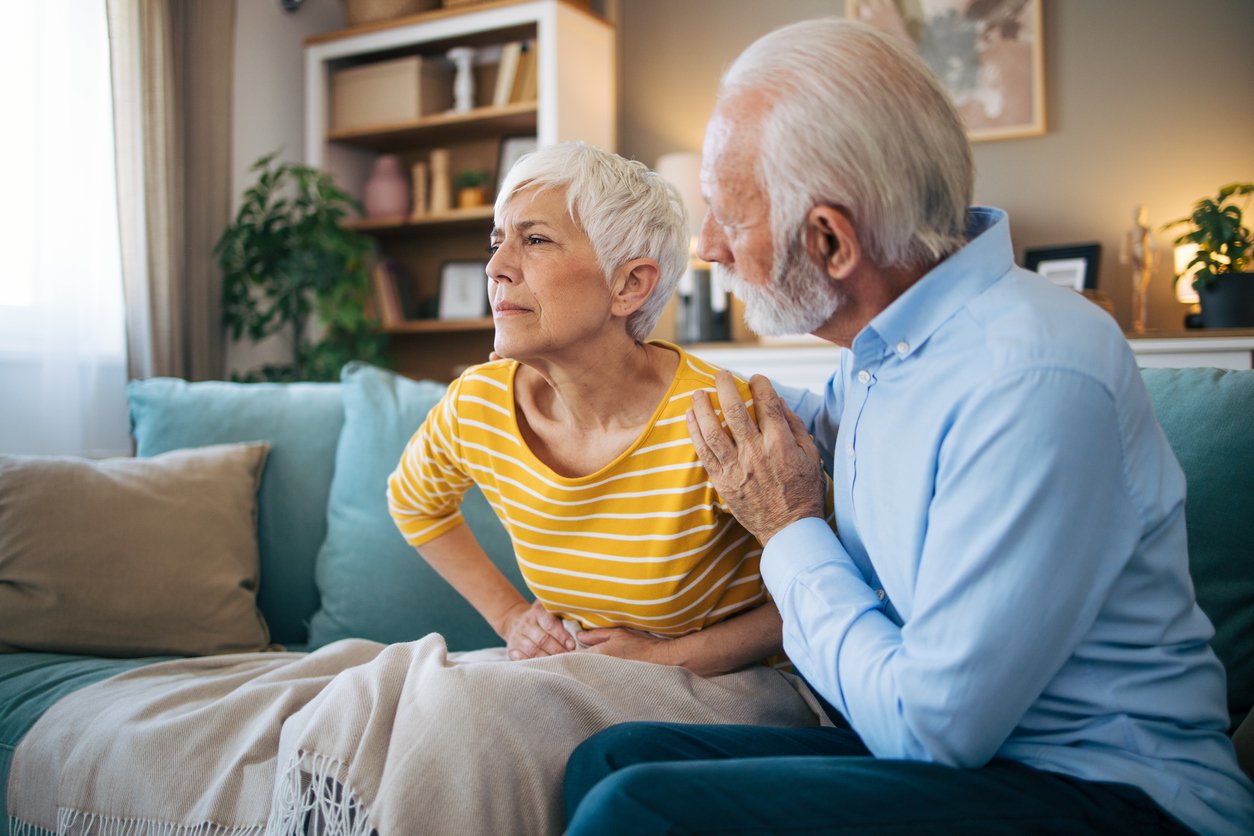
Some people may experience increased flatulence (that’s farts for all you classy folk) when eating jicama. Since the root is high in prebiotic fiber, which our stomachs can’t digest, it ferments in the digestive system, releasing gas into our colons. It’s similar to fermenting a jar of pickles or kimchi, and gas builds up or bubbles over. CO2 is released, which isn’t bad, but it can be uncomfortable (and smelly) to deal with.
When adding jicama to your diet, try a little bit at first to see how your gut handles it. With time, you should be able to increase the amount as your gut microbes get used to the increase in fiber.
When and Where to Find Jicama
Although jicama may not be as popular as potatoes, it’s becoming more widely consumed outside of Mexico and Latin America. Many grocery stores carry jicama in their produce section, usually near the other root and tuber vegetables. If you can’t find it there, check natural food stores, farmers markets, or Mexican grocery stores. If you still can’t find it, you may be able to make a special request with a produce manager.
Once you find a store with whole jicama roots, don’t pick the largest one in the pile. As jicama grows, it loses its crispness and flavor. The texture can also become a bit tougher, so choose a root on the smaller side.
You may also find pre-cut and packaged jicama sticks and jicama in the form of snack foods like chips or tortillas.
Fresh jicama is in season from late fall to spring in each hemisphere, making it available nearly year-round in many supermarkets.
How to Store Jicama
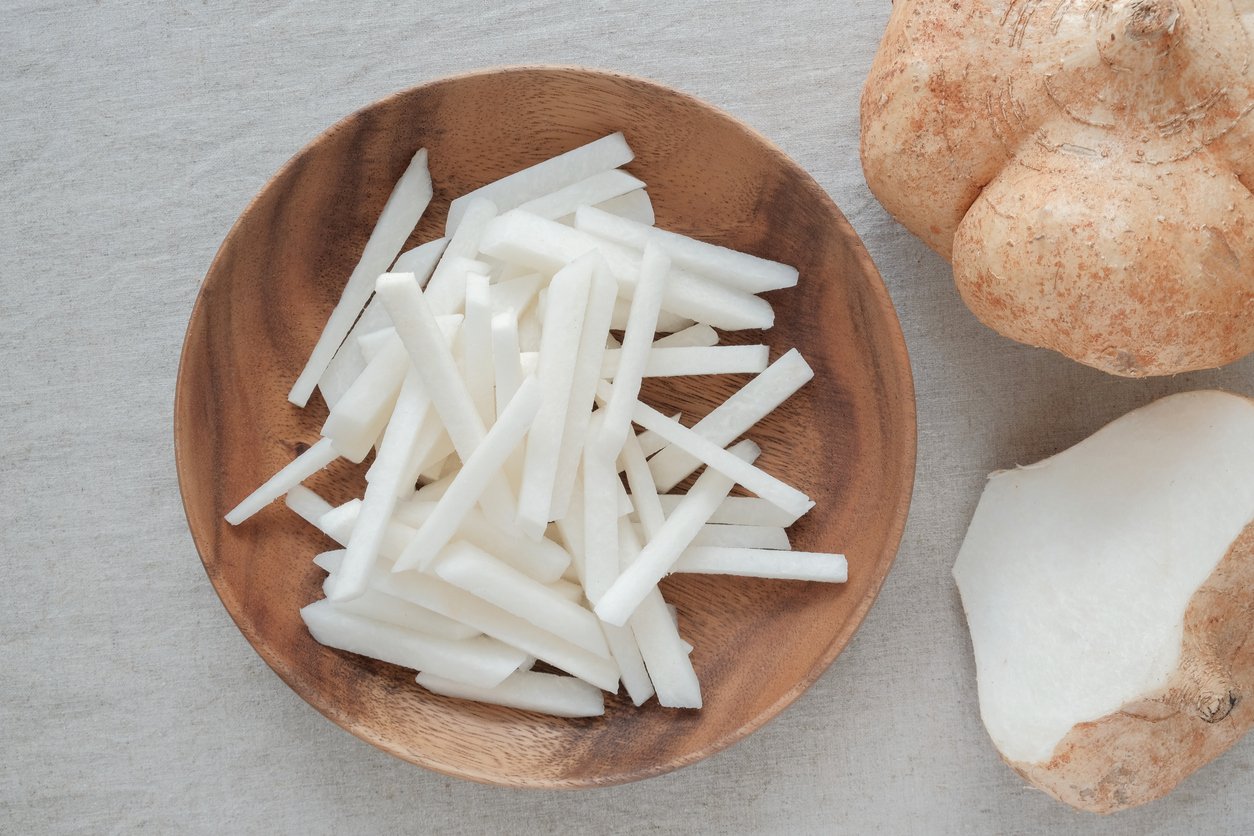
As for storage, jicama is a little higher maintenance than your average tuber. It doesn’t tolerate temperatures below 50 F. This means that the refrigerator isn’t ideal, although I find that it lasts for one to two weeks in a fridge if left unpeeled.
If you’re aiming for optimal storage, keep your jicama in a root cellar, basement, garage, or other place in your home that stays between 53 F and 60 F. Here, it can stay fresh for up to two months.
Once cut, jicama can last in the refrigerator for about one week in an airtight container. Check for weird, sour smells, mold, or sliminess before eating to ensure it hasn’t gone bad.
Of course, the best way to store jicama is not to store it! Bring it home and start using it right away!
How to Eat Jicama
On the outside, jicama is rough and papery, like a turnip or rutabaga. Inside, it has juicy, crunchy, white starch similar in texture to a crisp pear or water chestnut.
When raw, jicama tastes like a crunchy, mildly sweet apple. Its starchy flavor complements the flavors of many foods and works well in salads, savory dishes, and even some sweet ones.
Jicama is sold by street vendors in Latin America, where people often enjoy it raw and sometimes sprinkled with lime juice, cayenne pepper, or Tajin seasoning.
So, what else can you do with jicama roots? Many people enjoy them raw, cut into jicama sticks or thin rounds, used in slaws, and cubed into salads. Just remove the skin and slice in whatever way suits your fancy.
This video shows you how to tell if a jicama is ripe and how to prepare it raw.
You can also cook jicama in stir-fries and soups, mash it like potatoes, or bake it into crispy jicama chips. Some people even recommend slicing jicama thinly and using it as a soft tortilla or handheld taco shell. Jicama wraps are also available in some grocery stores or Latin American markets.
Healthy Jicama Recipes To Try
Dive into jicama’s crisp, refreshing goodness with these three irresistible recipes! Perfect for adding a satisfying crunch and a hint of sweetness to your meals, jicama shines in every dish — from zesty fries to flavorful tacos and a vibrant salad.
Whether you’re a jicama newbie or a seasoned fan, these recipes will introduce you to new and delicious ways to enjoy this versatile root vegetable. Get ready to make jicama the star of your kitchen!
1. Jicama Pomegranate Salad
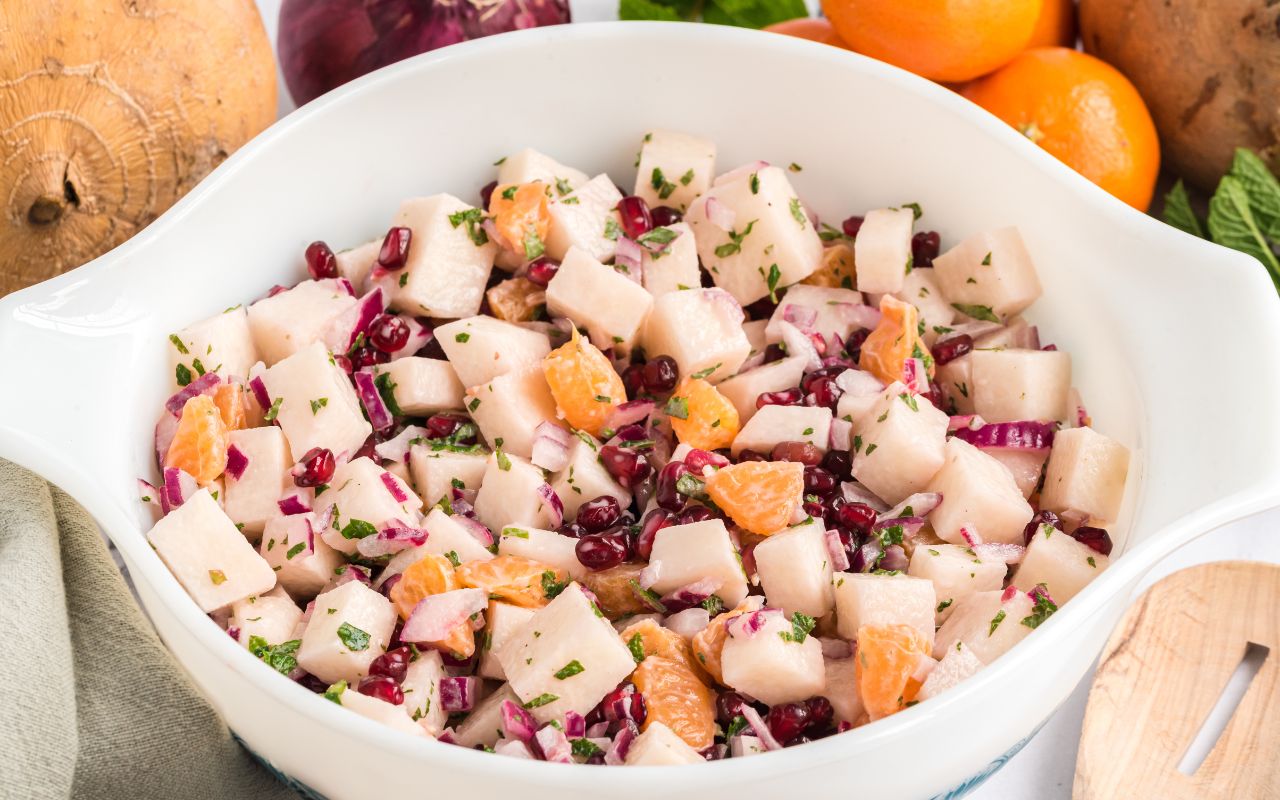
Jicama Pomegranate Salad is a sweet, juicy, and refreshingly crisp dish, with jicama taking center stage! If you’re new to jicama, you’re in for something special. This root vegetable has a mildly sweet flavor and a delightful crunch, similar to an apple but with a unique twist. Combined with pomegranate, mandarin oranges, and mint, the jicama brings an extra burst of freshness that makes this salad truly unique. The mix of sweet and savory flavors and crunchy textures create a tasty, refreshing salad that’s perfect as a side dish for any season.
2. Lime Chili Jicama Fries
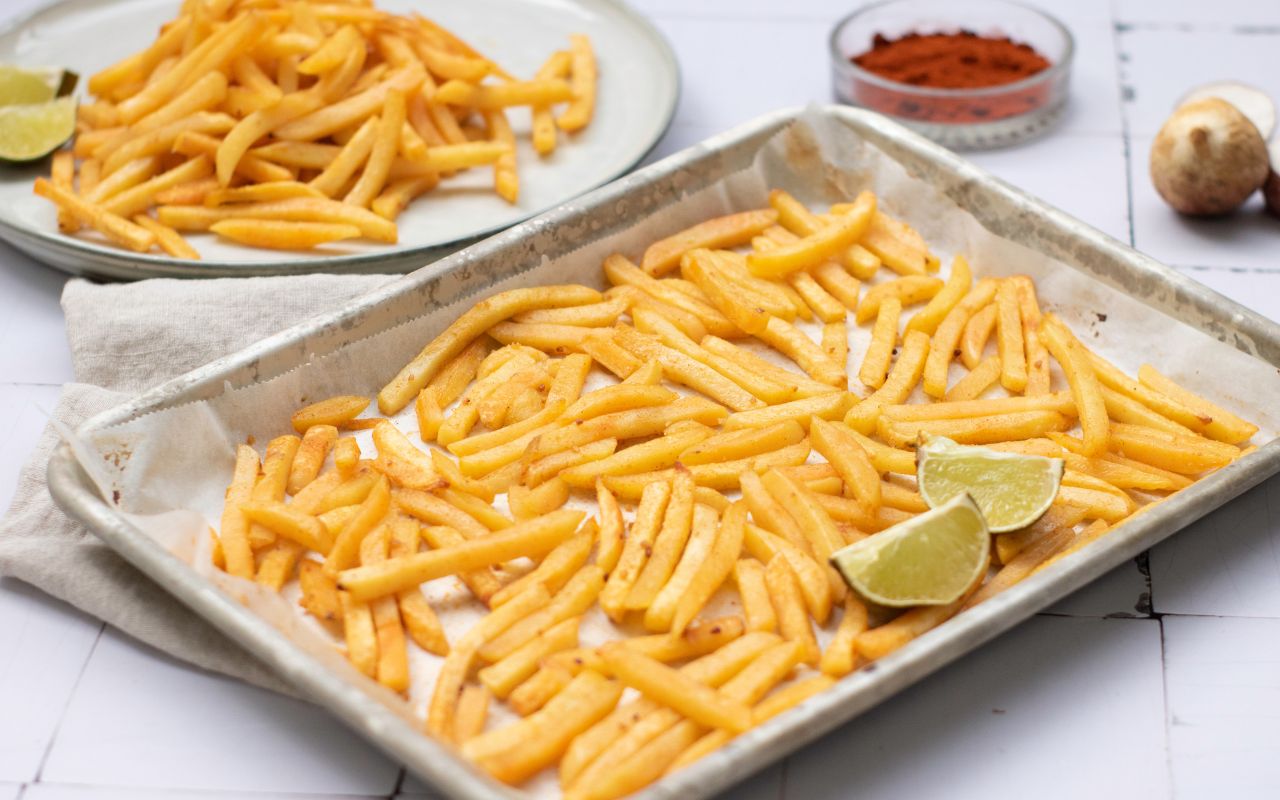
Get ready to fall in love with jicama in a whole new way with Lime Chili Jicama Fries! This crunchy, mildly sweet root vegetable transforms into a vibrant, zesty snack when tossed with fresh lime juice, a hint of chili powder, and a sprinkle of onion powder. Drizzled with extra virgin olive oil or avocado oil, these fries are roasted to perfection, delivering a flavor-packed bite with every crunch. If you haven’t explored the magic of jicama yet, this is the perfect recipe to dive in and discover just how versatile and delicious it can be!
3. Tacos with Refried Beans and Jicama Slaw

Tacos with Refried Beans and Jicama Slaw bring a delightful twist to your taco night with the refreshing addition of jicama. This crisp and mildly sweet root vegetable adds a refreshing crunch to the slaw, perfectly balancing the warm, savory flavors of the refried beans and spices. Jicama’s versatility shines in this dish, complementing the creamy avocado and zesty hot sauce, making each bite a flavorful and texturally exciting experience. Whether you’re new to jicama or already a fan, these tacos are a delicious way to explore its unique taste and crunch.
Here’s to Jicama
If you’re looking for a new, healthy vegetable to add to your diet, then jicama could be the perfect option. Jicama is good for your gut! It’s loaded with valuable fiber and a rich source of antioxidants, vitamins, and minerals that benefit your health. And it’s versatile, refreshing, and delicious. Prepared the right way, it might even become a new household favorite.
Tell us in the comments:
- Have you tried jicama? What other root vegetables do you enjoy?
Featured Image: iStock.com/eedology



